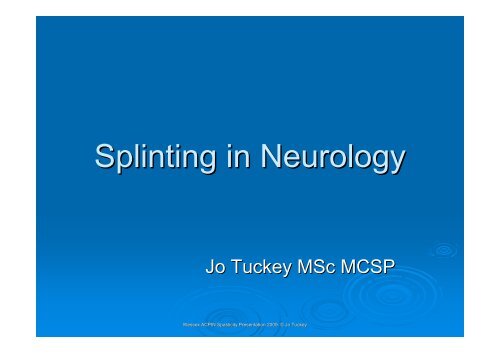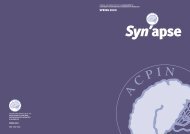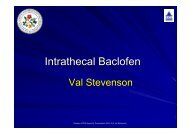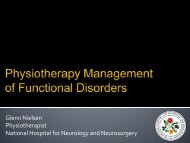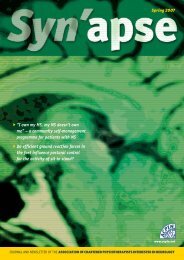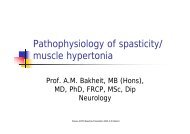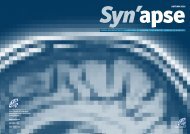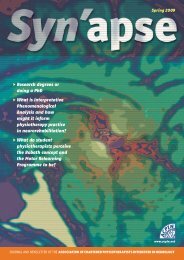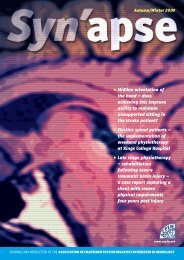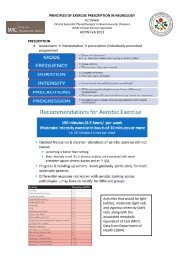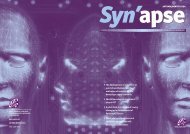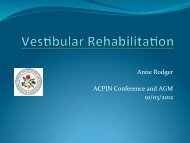Splinting in neurology - Tuckey - acpin
Splinting in neurology - Tuckey - acpin
Splinting in neurology - Tuckey - acpin
You also want an ePaper? Increase the reach of your titles
YUMPU automatically turns print PDFs into web optimized ePapers that Google loves.
<strong>Spl<strong>in</strong>t<strong>in</strong>g</strong> <strong>in</strong> Neurology<br />
Jo <strong>Tuckey</strong> MSc MCSP<br />
Wessex ACPIN Spasticity Presentation 2009. © Jo <strong>Tuckey</strong>
<strong>Spl<strong>in</strong>t<strong>in</strong>g</strong> <strong>in</strong> Neurology<br />
‣ When should spl<strong>in</strong>t<strong>in</strong>g be considered<br />
‣ How to choose the most appropriate spl<strong>in</strong>t<br />
or position for spl<strong>in</strong>t<strong>in</strong>g.<br />
‣ Practicalities of provid<strong>in</strong>g a spl<strong>in</strong>t<strong>in</strong>g<br />
regime.<br />
‣ Outcome measures for determ<strong>in</strong><strong>in</strong>g effect.<br />
‣ What is the evidence.<br />
Wessex ACPIN Spasticity Presentation 2009. © Jo <strong>Tuckey</strong>
Def<strong>in</strong>ition<br />
‣ “Spl<strong>in</strong>ts and casts are external devices<br />
designed to apply, distribute or remove<br />
forces to or from the body <strong>in</strong> a controlled<br />
manner to perform one or both basic<br />
functions of control of body motion and<br />
alteration or prevention <strong>in</strong> the shape of<br />
body tissue.”<br />
‣ Rose 1986<br />
Wessex ACPIN Spasticity Presentation 2009. © Jo <strong>Tuckey</strong>
1. When should spl<strong>in</strong>t<strong>in</strong>g be<br />
considered<br />
Spl<strong>in</strong>ts can be considered for any of the<br />
follow<strong>in</strong>g reasons:<br />
‣ To ma<strong>in</strong>ta<strong>in</strong> range of movement.<br />
‣ To rega<strong>in</strong> range of movement.<br />
‣ For function<br />
Wessex ACPIN Spasticity Presentation 2009. © Jo <strong>Tuckey</strong>
Examples<br />
Wessex ACPIN Spasticity Presentation 2009. © Jo <strong>Tuckey</strong><br />
Edwards (2002)
Examples<br />
Wessex ACPIN Spasticity Presentation 2009. © Jo <strong>Tuckey</strong>
Examples<br />
Wessex ACPIN Spasticity Presentation 2009. © Jo <strong>Tuckey</strong><br />
Edwards (2002)
Examples<br />
‣ So what does the spl<strong>in</strong>t actually do to<br />
ma<strong>in</strong>ta<strong>in</strong> or rega<strong>in</strong> ROM<br />
• Muscles and soft tissues constantly held <strong>in</strong> a<br />
lengthened or shortened position will adapt to<br />
that position and become longer or shorter.<br />
• The spl<strong>in</strong>t either prevents this occurr<strong>in</strong>g <strong>in</strong> ‘at<br />
risk’ muscle groups or re alters the length by<br />
provid<strong>in</strong>g a prolonged low load stretch to the<br />
shortened muscles.<br />
Wessex ACPIN Spasticity Presentation 2009. © Jo <strong>Tuckey</strong>
‣ Moseley (1993) - 19 HI subjects. Casted<br />
for 7 days. Improvement seen of between<br />
3-3636 degrees of passive ankle dorsiflexion<br />
<strong>in</strong> 28/32 limbs. Statistically significant.<br />
‣ Moseley (1997) - Similar study. 9 HI<br />
subjects. Methodology tighter. Same<br />
result.<br />
Wessex ACPIN Spasticity Presentation 2009. © Jo <strong>Tuckey</strong>
‣ Moseley et al 2008<br />
‣ Serial cast<strong>in</strong>g versus position<strong>in</strong>g for the<br />
treatment of elbow contractures <strong>in</strong> adults<br />
with traumatic bra<strong>in</strong> <strong>in</strong>jury: a randomised<br />
controlled trial<br />
Wessex ACPIN Spasticity Presentation 2009. © Jo <strong>Tuckey</strong>
Moseley et al 2008<br />
• 26 Subjects<br />
• Susta<strong>in</strong>ed TBI<br />
• Elbow contracture of at least 15˚<br />
• Treatment group casts applied for 2 weeks,<br />
cast changed after 7 days<br />
• Position<strong>in</strong>g group had passive stretch applied<br />
to the elbow flexors for 1 hour a day<br />
Wessex ACPIN Spasticity Presentation 2009. © Jo <strong>Tuckey</strong>
‣ Moseley et al 2008<br />
• Results greater reductions <strong>in</strong> elbow flexion<br />
contracture with serial cast<strong>in</strong>g by an average<br />
of 22˚.<br />
• Results not ma<strong>in</strong>ta<strong>in</strong>ed. Dim<strong>in</strong>ished by half<br />
one day post <strong>in</strong>tervention and completely<br />
disappeared at 4 weeks follow up.<br />
Wessex ACPIN Spasticity Presentation 2009. © Jo <strong>Tuckey</strong>
Examples<br />
Wessex ACPIN Spasticity Presentation 2009. © Jo <strong>Tuckey</strong><br />
Edwards (2002)
Examples<br />
Wessex ACPIN Spasticity Presentation 2009. © Jo <strong>Tuckey</strong><br />
Edwards (2002)
2. Options – How to choose the most<br />
appropriate spl<strong>in</strong>t / position for spl<strong>in</strong>t<strong>in</strong>g<br />
‣ It depends upon what you are want<strong>in</strong>g to<br />
achieve.<br />
‣ On decid<strong>in</strong>g the most appropriate spl<strong>in</strong>t<br />
also depends upon:<br />
• Knowledge and skills of the treat<strong>in</strong>g therapist<br />
• Resources available<br />
Wessex ACPIN Spasticity Presentation 2009. © Jo <strong>Tuckey</strong>
How to choose the most appropriate spl<strong>in</strong>t<br />
‣ You should only make a spl<strong>in</strong>t us<strong>in</strong>g the<br />
material you are tra<strong>in</strong>ed to use.<br />
‣ A custom made spl<strong>in</strong>t may be equally as<br />
effective and might be more cost effective.<br />
NB politics / budgets<br />
Potential problems<br />
‣ Resources available for provision of<br />
spl<strong>in</strong>t<strong>in</strong>g materials<br />
Wessex ACPIN Spasticity Presentation 2009. © Jo <strong>Tuckey</strong>
How to choose the most appropriate spl<strong>in</strong>t<br />
‣ Whether we like it or not, choos<strong>in</strong>g the<br />
most appropriate spl<strong>in</strong>t means:<br />
• Look<strong>in</strong>g at materials or products you have<br />
available and the skills you have with<strong>in</strong> your<br />
team.<br />
• Ask<strong>in</strong>g, ‘Will it do the job’<br />
Wessex ACPIN Spasticity Presentation 2009. © Jo <strong>Tuckey</strong>
How to choose the most appropriate spl<strong>in</strong>t<br />
‣ Removable versus non removable<br />
‣ NB Problems of pressure<br />
‣ Advantages of removable spl<strong>in</strong>ts:<br />
• Cut them off from the start<br />
• Daily check<strong>in</strong>g / wash<strong>in</strong>g of sk<strong>in</strong><br />
• Can monitor effect<br />
• Can still get “24 hr” effect if bandage back on.<br />
Wessex ACPIN Spasticity Presentation 2009. © Jo <strong>Tuckey</strong>
‣ Tim<strong>in</strong>g of spl<strong>in</strong>ts<br />
Pohl et al (2002)<br />
105 bra<strong>in</strong> <strong>in</strong>jured patients.<br />
Compared 5-75<br />
7 day cast<strong>in</strong>g <strong>in</strong>terval with 1-1<br />
4 days.<br />
Results Improvement seen <strong>in</strong> all patients<br />
still present after 1 month. 1-41<br />
4 days<br />
considered superior as reduced<br />
complications & discont<strong>in</strong>uation rates.<br />
Wessex ACPIN Spasticity Presentation 2009. © Jo <strong>Tuckey</strong>
The most appropriate position for spl<strong>in</strong>t<strong>in</strong>g<br />
‣ Need to consider this accord<strong>in</strong>g to the type<br />
of spl<strong>in</strong>t be<strong>in</strong>g made:<br />
• Backslab<br />
• Increas<strong>in</strong>g ROM<br />
• Ma<strong>in</strong>ta<strong>in</strong><strong>in</strong>g ROM<br />
Wessex ACPIN Spasticity Presentation 2009. © Jo <strong>Tuckey</strong>
3. Practicalities of a spl<strong>in</strong>t<strong>in</strong>g regime<br />
‣ Spl<strong>in</strong>ts need to be put on properly and taken off.<br />
‣ Problems need to be identified and action taken<br />
if found eg pressure areas.<br />
‣ Decisions need to be made as to the<br />
effectiveness of the spl<strong>in</strong>t and ongo<strong>in</strong>g need.<br />
‣ If you made or supplied it its your responsibility<br />
to put <strong>in</strong> place and document an appropriate<br />
regime<br />
‣ SO, BE REALISTIC!<br />
Wessex ACPIN Spasticity Presentation 2009. © Jo <strong>Tuckey</strong>
3. Outcome measures<br />
‣ Chang<strong>in</strong>g ROM is not enough.<br />
‣ Ask, what is that changed ROM required<br />
for<br />
‣ Cl<strong>in</strong>ical examples<br />
eg ROM at knees for stand<strong>in</strong>g or to be<br />
seated<br />
Hands that can function or for hygiene<br />
Wessex ACPIN Spasticity Presentation 2009. © Jo <strong>Tuckey</strong>
4. The evidence – what does the literature<br />
say<br />
‣ Review paper:<br />
Mortenson et al (2003) The use of casts<br />
<strong>in</strong> the management of jo<strong>in</strong>t mobility and<br />
hypertonia follow<strong>in</strong>g bra<strong>in</strong> <strong>in</strong>jury <strong>in</strong> adults:<br />
A systematic review<br />
Wessex ACPIN Spasticity Presentation 2009. © Jo <strong>Tuckey</strong>
<strong>Spl<strong>in</strong>t<strong>in</strong>g</strong> - Literature<br />
‣ Aim<br />
To report on best practice for the use of<br />
cast<strong>in</strong>g <strong>in</strong> bra<strong>in</strong> <strong>in</strong>jury rehabilitation.<br />
Only 13 articles fulfilled the criteria.<br />
Wessex ACPIN Spasticity Presentation 2009. © Jo <strong>Tuckey</strong>
<strong>Spl<strong>in</strong>t<strong>in</strong>g</strong> - Literature<br />
3 categories emerged re: effect of<br />
cast<strong>in</strong>g:<br />
1.Reduction of spasticity – only 5/12<br />
measured properties of spasticity<br />
Awarded grade C<br />
Wessex ACPIN Spasticity Presentation 2009. © Jo <strong>Tuckey</strong>
<strong>Spl<strong>in</strong>t<strong>in</strong>g</strong> - Literature<br />
2. Passive ROM<br />
10 studies measured this and <strong>in</strong> all<br />
improvements were seen except 1 (but it<br />
was not the first aim)<br />
Awarded grade B<br />
Wessex ACPIN Spasticity Presentation 2009. © Jo <strong>Tuckey</strong>
<strong>Spl<strong>in</strong>t<strong>in</strong>g</strong> - Literature<br />
3. Function<br />
“Trends regard<strong>in</strong>g the effect of cast<strong>in</strong>g on<br />
‘function’ could not be identified from the<br />
<strong>in</strong>consistent results identified”<br />
No grade level of recommendation given<br />
Wessex ACPIN Spasticity Presentation 2009. © Jo <strong>Tuckey</strong>
<strong>Spl<strong>in</strong>t<strong>in</strong>g</strong> - Literature<br />
Therefore only improvement / prevention<br />
of loss of ROM suggested as hav<strong>in</strong>g<br />
sufficient evidence to support use of casts<br />
as best practice.<br />
Wessex ACPIN Spasticity Presentation 2009. © Jo <strong>Tuckey</strong>
<strong>Spl<strong>in</strong>t<strong>in</strong>g</strong> - Literature<br />
‣ The National Cl<strong>in</strong>ical Guidel<strong>in</strong>es for Stroke<br />
2008 state:<br />
If stretch<strong>in</strong>g alone does not control<br />
contractures, serial cast<strong>in</strong>g around a jo<strong>in</strong>t<br />
should be considered as a treatment for<br />
reduc<strong>in</strong>g contractures.<br />
Wessex ACPIN Spasticity Presentation 2009. © Jo <strong>Tuckey</strong>
<strong>Spl<strong>in</strong>t<strong>in</strong>g</strong> - Literature<br />
‣ The National Cl<strong>in</strong>ical Guidel<strong>in</strong>es for Stroke<br />
2008 state:<br />
Inflatable arm spl<strong>in</strong>ts envelop<strong>in</strong>g the hand,<br />
forearm and elbow, and rest<strong>in</strong>g wrist and<br />
hand spl<strong>in</strong>ts should not be used rout<strong>in</strong>ely.<br />
Wessex ACPIN Spasticity Presentation 2009. © Jo <strong>Tuckey</strong>
<strong>Spl<strong>in</strong>t<strong>in</strong>g</strong> - Literature<br />
Lann<strong>in</strong> et al 2003<br />
• 28 subjects<br />
• Inclusion criteria – s<strong>in</strong>gle stroke / BI lead<strong>in</strong>g to<br />
hemiparesis no more than 6 months before<br />
• Unable to actively extend wrist<br />
• Rx group wore a functional rest<strong>in</strong>g hand spl<strong>in</strong>t<br />
for up to 12 hours a night<br />
• Both Rx and control group had x2 / day 30<br />
m<strong>in</strong> stretches applied to hands<br />
Wessex ACPIN Spasticity Presentation 2009. © Jo <strong>Tuckey</strong>
<strong>Spl<strong>in</strong>t<strong>in</strong>g</strong> - Literature<br />
Lann<strong>in</strong> et al 2003<br />
Result<br />
No difference between groups<br />
BUT<br />
Unable to conclude the effect of hand<br />
spl<strong>in</strong>ts alone as all subjects additionally<br />
received stretches<br />
Wessex ACPIN Spasticity Presentation 2009. © Jo <strong>Tuckey</strong>
‣ Lann<strong>in</strong> 2003<br />
<strong>Spl<strong>in</strong>t<strong>in</strong>g</strong> - Literature<br />
Is hand spl<strong>in</strong>t<strong>in</strong>g effective for adults follow<strong>in</strong>g<br />
stroke A systematic review and<br />
methodological critique of published research.<br />
Conclusion<br />
There is <strong>in</strong>sufficient evidence to support or<br />
refute effectiveness of hand spl<strong>in</strong>t<strong>in</strong>g follow<strong>in</strong>g<br />
stroke.<br />
Wessex ACPIN Spasticity Presentation 2009. © Jo <strong>Tuckey</strong>
<strong>Spl<strong>in</strong>t<strong>in</strong>g</strong> - Literature<br />
‣ Lann<strong>in</strong> et al 2007<br />
• 63 subjects<br />
• All with<strong>in</strong> 8 weeks of hav<strong>in</strong>g stroke<br />
• No active wrist extension<br />
• 3 groups:<br />
Rout<strong>in</strong>e therapy (no stretches) plus spl<strong>in</strong>t <strong>in</strong> neutral<br />
Rout<strong>in</strong>e therapy (no stretches) plus spl<strong>in</strong>t <strong>in</strong> extension<br />
Rout<strong>in</strong>e therapy ( no stretches) ie control group<br />
Wessex ACPIN Spasticity Presentation 2009. © Jo <strong>Tuckey</strong>
<strong>Spl<strong>in</strong>t<strong>in</strong>g</strong> - Literature<br />
‣ Lann<strong>in</strong> 2007<br />
Result<br />
There was no significant difference between<br />
the groups<br />
Conclusion<br />
These f<strong>in</strong>d<strong>in</strong>gs suggest that the practice of rout<strong>in</strong>e<br />
wrist spl<strong>in</strong>t<strong>in</strong>g soon after stroke should be<br />
discont<strong>in</strong>ued<br />
Wessex ACPIN Spasticity Presentation 2009. © Jo <strong>Tuckey</strong>
<strong>Spl<strong>in</strong>t<strong>in</strong>g</strong> the wrist and hand<br />
‣ How should these results accurately<br />
<strong>in</strong>form cl<strong>in</strong>ical practice<br />
‣ How can these results be mis<strong>in</strong>terpreted<br />
and impact upon cl<strong>in</strong>ical practice<br />
Wessex ACPIN Spasticity Presentation 2009. © Jo <strong>Tuckey</strong>
<strong>Spl<strong>in</strong>t<strong>in</strong>g</strong> <strong>in</strong> Neurology<br />
‣ And f<strong>in</strong>ally…<br />
ACPIN spl<strong>in</strong>t<strong>in</strong>g guidel<strong>in</strong>es.<br />
Wessex ACPIN Spasticity Presentation 2009. © Jo <strong>Tuckey</strong>


